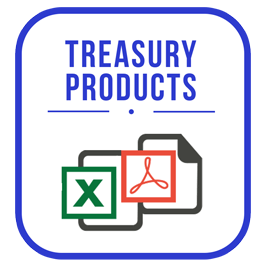Treasury Crash Course - Package
About the Course
The Treasury Crash Course is an introductory course on treasury operations that provides a mix of core treasury topics as well as certain application topics. The primary focus of the core topics is to introduce key terms used in a bank’s Treasury Operations whereas the applications elaborate on key concepts such as treasury profitability, derivatives products and pricing, asset liability management, liquidity management.
The course covers the following topics:
- What is a Treasury?
- The Treasury Function
- Cross Selling Treasury Products
- Derivatives Terminology crash course (including products and payoff profiles)
- Derivatives Products and Pricing
- Advanced derivative products (such as structured and credit products)
- Calculating Forward Prices and Rates in EXCEL
- Other Treasury Formulas
- Asset Liability Management
- Liquidity Management
- Setting Limits
- Treasury Profitability (FX and Capital Market Desks)
- Calculating VaR at Risk – step-by-step methodologies, caveats and qualifications
- Build maturity and liquidity profiles for deposits and advances
a.The Money Market Desk
b.The FX Desk
c.The Equity Desk
d.The Specialized Desks
e.What do treasuries do?
f.Difference between a corporate and bank treasury function
a.FX desk Trade Flows
b.Treasury operations, including user roles and activities for the front, middle and back office functions
c.Common Treasury terminology
d.Treasury markets (such as FX Market, Money Market, Capital Market) and products
a.Five core themes for treasury customer discussions (Price, Risk, Value, Products and Limits)
b.Core Treasury products and TMU customer reactions
a.Standard Template for Evaluating Derivatives
b.Types of derivatives (forwards, futures, options, swaps)
c.Product Variations for each type
a.Types of risks
b.Duration and Convexity
c.Risk Measurement tools (such as MVE, EAR, NIIR, Gaps, Cost to Close)
d.ALM Applications (immunization, dedication)
a.Ratios and Analysis
b.Contingency Funding Plan
c.Liquidity Enhancement Techniques
a.Risk Limits and Control Process (including an overview of the types of limits and limit hierarchy)
b.A detailed look at limits (including stop loss, VaR, regulatory, duration, convexity, PVBP, PSR, counterparty, settlement risk, concentration limits)
c.Application of limits to products
d.Liquidity Risk limits (including cash flow mismatch, maturity, concentration, contingent liability limits)
e.Interest Rate Risk limits
f.Limit Breach, Exception Processing and Reporting and Action Plans for trigger zones
Value at risk with liquidity premium
This course presents a VaR based approach for quantifying market liquidity risk with a detailed walkthrough of the accompanying EXCEL example. Market risk measures are calculated for base and stressed scenarios in turn for markets where trading volume is unlimited and where it is constrained. The latter measure produces a metric that is adjusted for market liquidity risk and inclusive of the liquidity premium.
The 7 EXCEL files that cover the following concepts:
- ALM Measurement tools - Market Value of Equity (MVE)
- ALM Measurement tools - Earnings at Risk (EAR)
- ALM Measurement tools - Cost to Close – Liquidity Risk
- ALM Measurement tools - Cost to Close – Interest Rate Risk
- Duration and Convexity Example
- Value at Risk calculations using the Variance-covariance (VCV) and Historical Simulation approaches
- Adjusting market risk VaR estimates for market liquidity risk
Learning objectives
After taking this course you will be able to:
- List the activities performed by a treasury group
- Describe the various desks in a treasury group
- Distinguish between a bank treasury and a corporate treasury
- Explain the roles of the front office, middle office & back office functions
- Define the Four Eye Principle
- Define confirmation, settlement, reconciliation as it relates to treasury functions
- Describe risks faced by Treasury
- Summarize the different treasury products in the Foreign Exchange Market, Money Market & Capital Market
- Outline common derivatives terminology, such as products (e.g. forwards, options) and payoff profiles
- State the elements of a standard template used by investment banks to review a derivative transaction for risk & fit
- Elaborate on the factors that affect the price of an option
- Calculate forward prices and forward rates
- List and describe product variations for options, forwards, futures and swaps
- Discuss in brief complex structured & credit products such as cross currency swaps, participating forwards, equity linked notes, capital protected notes, commodity linked notes, range accruals, switchables, interest rate differential trades, credit default swaps, total return swaps and collateralized debt obligations
- Present a framework for empowering client facing treasury teams to go out and cross sell high value, high margin trading concepts to clients
- Clarify the five core themes used for treasury customer discussions
- Illustrate the core treasury products
- Highlight & address common customer reactions to treasury products offered
- Determine treasury profitability for the FX & Equity desks
- Calculate the cost of deposit
- Describe the risks associated with asset liability management
- Estimate duration and convexity of a security
- Differentiate between Macaulay, Modified and Effective Duration
- Demonstrate how to build and use ALM measurement tools, such as the Fall in Market Value of Equity, Earnings at Risk, Cost to Close, Rate Sensitive Gap, Price Sensitive Gap, Liquidity Gap, Net Interest Income at Risk & Duration Gap
- Evaluate various liquidity ratios
- Review the essential elements of a Liquidity Contingency Funding Plan
- State the core principles of a limit setting process
- Describe the various types of limits
- Outline the limit setting process framework
- Calculate Value at Risk
- Build maturity and liquidity profiles for deposits and advances in EXCEL
- Explain an approach for determining the loss attributable to market liquidity risk
- Calculate market liquidity risk under base and stressed market risk scenarios
Prerequisites
The candidate should be comfortable with basic mathematics, statistics, probability and EXCEL..
Target Audience
This course is for beginners in the finance field, banking, corporate, treasury and sales teams, and banking professionals and individuals responsible for asset liability management and risk management within banks, insurance companies and mutual funds.

